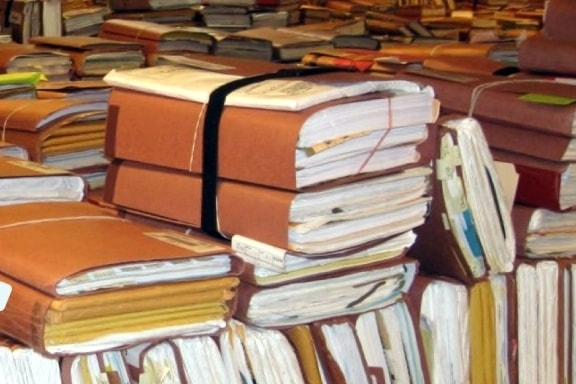The wrong mindset
In most people’s minds, ‘filing’ is all about putting things away. That is not the point, though: the reason we file documents is to be able to find them when we need them sometime in the future! If you approach filing from this angle, not only will you be more likely to see the need for filing, it will also allow you to make better choices about what to keep and what to chuck away. For one thing, this approach will start from the idea of documents being useful and/or you being required to keep them, not from a point of view that makes you keep files ‘just in case’. Waiting too long before filing Let’s face it: it takes a rather unusual personality that likes filing documents. A huge pile of unfiled documents – especially the paper kind on your desk on in your filing tray – makes it all the more unlikely you’ll even start that task. The most painless approach to filing is to do it regularly, but not too often. This sounds a little vague, of course, but it all depends on how much stuff you need to file. Here are the two rules I tend to pass on (and use myself):
Using both these rules in parallel will make sure that you’ll never have to spend too much time with either filing or searching for documents. Too much in one place This is a particularly common mistake people make with their electronic files. In the days when new documents were far and wide between, having one folder called “DOCUMENTS” was an option, but these days not only do we have a load of different types of documents, but also we create them by the dozen in the time it takes to take a phone call and putting down the phone again. You need to find a the right moment when a folder becomes too full of stuff and finding things becomes harder than creating a subfolder! My rule of thumb is to consider a subdivision whenever you find that you have to scroll too long for comfort. The strategy here would be to identify documents that go together in a particular way and create a subfolder for those, leaving the rest where they are, at least for now. A similar rule applies to paper filing systems: when it starts taking too long to find things, identify some things that belong together logically and create separations in your folder. Too much structure This is a common mistake made by those of us aiming for uniformity in their electronic or physical folder structure, e.g.: each client folder has the same substructure (‘correspondence’, ‘contracts’, ‘working files’, ‘archive’ and ‘production’) from the start. In many cases, some of those folders will stay empty as they don’t apply specifically to this project, or the project turns out to be a no-go. Either way, you will be losing time creating those structures AND searching for your documents because you’ll have to open each subfolder to find out what’s there. The better strategy is one that saves all documents in the client folder, and only to create subfolders when necessary – and those could then follow specific rules set up to make the subfolders uniform throughout the filing system. That would mean having a list of common folder names and the nature of their contents. Filing unnecessary documents Filing and retrieval of documents can be simplified by making sure you only file documents that you actually need. Think first, then file. My experience shows that a lot of documents are filed without thinking – a typical result of people doing a task they don’t like doing! For each document you file, ask yourself a simple question:
Don’t be afraid of throwing things out. Lack of a long-term archive Once your file system is starting to bulge (and that is especially true with physical folders), you may find that those folders contain documents that you don’t have to have at your fingertips at all times, but want to refer to when necessary. Moving those documents into an archive has two major advantages:
Keeping things forever Having a properly running filing system and an archive does not take away the need to removing things from either one of them on a regular basis. Many things are not meant to be kept forever: remember: filing/archiving is about retrieving information, and if you have come to the conclusion that the information contained in a particular document is no longer necessary there is really no reason to keep it, right? Here are a couple of simple strategies to keep this part of filing short and sweet:
Even with all those good standards, you will have to take some time out and go through your files and archive properly, moving documents from your (day to day) filing system to the (long-term) archiving, AND cleaning out documents from the archive that are obsolete or superseded by newer versions, or that have simply ceased to be relevant at all. I recommend setting time aside for this at least once a year, if not more often if you are dealing with a lot of documents. The good news is, following the strategies outlined above will shave a lot of time off your regular filing and archiving sessions. Now, go evaluate your filing strategies and find out if you are making any of the above mistakes. If so, maybe it's time to take a step forward and start avoiding some of them? Comments are closed.
|
Ask the ClutterMeisterIdeas to help clear away the mess in your homes and in your minds.
Feel free to share any of my posts, but please put in a backlink to the original blog post. Thank you. The author
Hi, my name is Tilo Flache. My mission: help clients declutter mind and space.
This blog contains pointers for your journey towards a happier living experience. Archives
November 2023
|



 RSS Feed
RSS Feed




